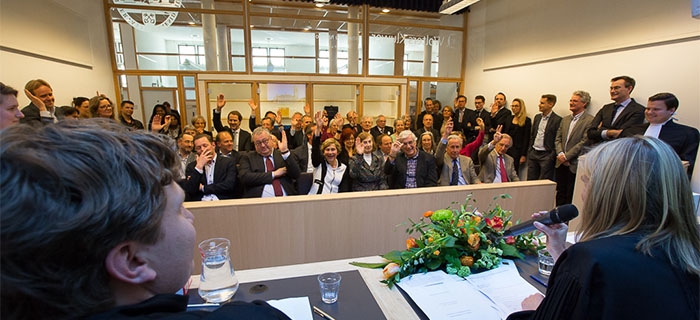
Learning to argue a case in a ‘real’ court
Thanks to an extremely successful crowdfunding campaign, the Leiden Law School now has a mock courtroom for Moot Court, the course that teaches students advocacy skills. ‘The more realistic it is, the better. Then students grow into their role.’
Case on Syria
‘Sovereignty is the cornerstone of international law, but is it also a shield behind which states can perpetrate flagrant violations of human rights?’ Wearing a black gown, law student Tobias Veldkamp poses incisive rhetorical questions like a seasoned lawyer. To inaugurate the new courtroom, he and master’s student Colette Bavinck are practising on a real case: Syria has brought the United States, France and Great Britain before the International Criminal Court for their bombardments of Syrian territory. The Moot Court lecturers are playing the critical members of the court today.
Not a theatrical production
Students usually practise advocacy skills in normal lecture halls. To have its own courtroom – complete with wooden bench, lecterns and public gallery – had figured on the Faculty of Law’s wishlist for years. ‘The more realistic it is, the better,’ says Clementine Breedveld-de Voogd, director of Moot Court at the Leiden Law School. ‘It shouldn’t turn into a theatrical production, of course. But the bench and black robe help students feel more like a lawyer, which means they soon forget their nerves and grow into their role.'
Particular thanks to all donors
At the opening of the courtroom, Dean Rick Lawson expressed his thanks to all the sponsors who had made it possible. About 45,000 euros was raised in the space of two months. The 129 donors are a mixed bunch of Leiden students, staff, alumni, contacts of the Faculty of Law and businesses. Breedveld: ‘The success is due to the connection with the Faculty that all the generous donors feel.’ As a thank you, the names of the donors appear in elegant lettering on the windows of the courtroom.
Courtroom is the heart of the Faculty
‘American universities like Harvard and Cornell have a Moot Court courtroom, too,’ says Lawson. ‘Together with the library, this forms the heart of the Leiden Law School, because the courtroom stands for arguing, creativity and improvisation. It is fantastic that we now have one!’
Named after Professor Nieuwenhuis
The courtroom is named after Hans Nieuwenhuis, the highly esteemed emeritus professor of private law in Leiden who died in 2015. Breedveld-de Voogd: ‘Moot Court is about good rhetoric and style, convincing others and incisive debate on justice and injustice. Nieuwenhuis was a master of the art.’
Moot Court
Each year nine hundred students follow the Moot Court course. They spend three months preparing a case. During this period, they receive intensive training, in such forms as video training. This culminates in the grand finale, when they argue a case for the first time. The role of judge is played by 150 members of the legal profession.
(LvP)
